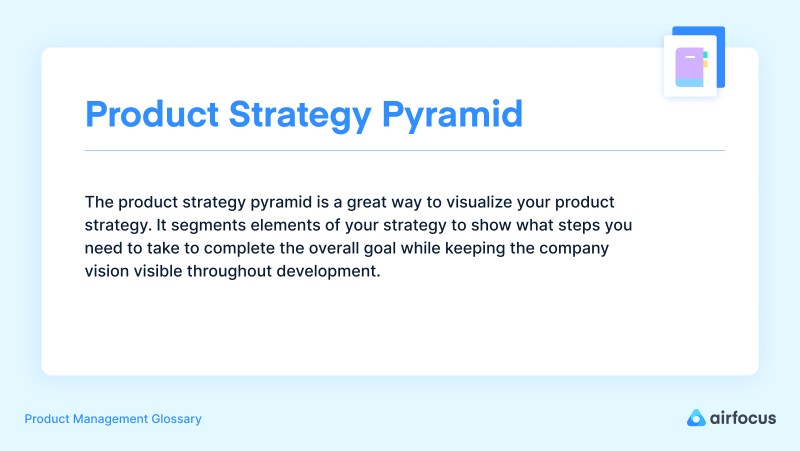Product Strategy Pyramid
What is a product strategy pyramid?
Product Strategy Pyramid
The product strategy pyramid is a great way to visualize your product strategy. It segments elements of your strategy to show what steps you need to take to complete the overall goal while keeping the company vision visible throughout development.
4 components of product strategies
A strong product strategy is built around many components that come together to build a plan that’s ready to execute. While some of these components are specific to the product you’re planning, there are four key components of all product strategies.
Customers
You need to define your target audience early on. This will help shape your plans to ensure your customers receive maximum value.
Competitors
There are two types of businesses: those that follow the crowd and those that blaze the trail. By looking at what your competitors are doing, you can create new products that address their pitfalls and attract new customers.
Business
A good product strategy needs to account for how the product will address your business goals. If your goal is to increase your customer base, consider rethinking your pricing strategies.
Environment
Your product strategy needs to reflect the current state of your industry. This usually means reacting to a substantial change in your market and ensuring you aren’t left behind.
What are the stages of product strategy?
Stage 1 - Instinct
It can be tough for startups to figure out where to go next. You need to make many key decisions by trusting your gut. As your experience grows, you’ll quickly realize this is unsustainable. That realization will move you on to stage two.
Stage 2 - Simple prioritization
This stage is where businesses start to mature their product strategies. They’ll use simple prioritization techniques to make more informed decisions about the products they create.
Stage 3 - Prioritize around objectives
Stage three sees your prioritization align with your business vision. Your product strategy will now be cohesive with your overall goals and objectives.
Stage 4 - Define strategy and measurable results
Stage four brings accountability to your product strategy. You will take what you learned from the last stage and define what success will look like. You will also define how you'll measure your results.
Stage 5 - Get everyone on board
Product strategy works best when the entire business works towards the same goals. The final step is to ensure everyone within the organization who has a stake in the product is on the same page.
How to create a product strategy pyramid
The product strategy pyramid is made up of five segments, and each builds toward the company’s vision. Let’s quickly look at each segment and what they represent.
Vision
The product strategy pyramid is a top-down framework that infuses the company vision throughout the development process. As a high-level view of the company’s goals, the vision sits on top of the pyramid to emphasize its importance.
Mission
This is where we start looking at tactics that could make the company vision a reality. We’re not making concrete, actionable business plans at this stage, but we are coming up with ideas that give a sense of how we can realize the company vision.
Strategy
Now we have defined our vision and mission, we can start forming our product strategy. This stage involves identifying gaps in our target markets that we can leverage.
Strategies need to be built around a sense of realism. We need achievable outcomes that help build toward our overall vision. With that in mind, it’s important to avoid specific metrics or numbers.
Product plans
This is where we start to get into the real nitty-gritty of the product. Product plans are all about how we execute our strategy. We will allocate resources, define our budgets, and set our schedules.
Roadmap
The final segment of the product strategy pyramid is our roadmap. This is where our product plan will be visualized with timeframes and deadlines (if applicable.) This is how we communicate to stakeholders and other parties how we will achieve the company mission with this product.
How can airfocus help you create a product strategy pyramid?
At airfocus, we have everything you need to create your product strategy pyramid. Our prioritization tools can help you align your product strategy with your business goals. And you’ll find plenty of roadmap templates and guidance to help you build your strategic roadmap and present it to stakeholders.
We can also help you share your strategic roadmap outside your company with our public portal.

General FAQ

Glossary categories
Create effective product strategy

Experience the new way of doing product management








